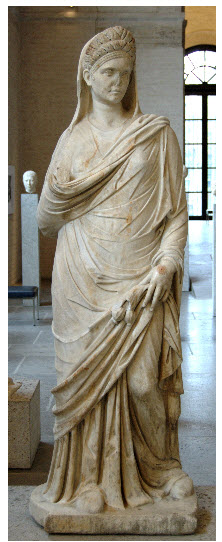

Rome was definitely a masculine, militaristic society. Its founding myth says that Rome was founded by two motherless twins who, notably were raised by a she-wolf rather than a woman. Later, as the community grew, the men of Rome acquired women through kidnapping Sabine women from the neighboring tribes. The Romans were proud of this crime, suggesting that they regarded women as something that could be acquired like property.
Indeed, their early moral and legal code reflected the masculine nature of this society. Each head of the family, the pater familias, was the king of his own household with the power of life and death over his wife and children. The activities of women were heavily circumscribed.
But as time went on, changes in Roman society meant that the reality of women's status within society and the family no longer reflected traditional Roman roles or laws. They acquired more and more independence, even daring to form liaisons of the heart and influencing their families. Although there was never a Roman empress, several powerful Roman women ruled in all except name, exerting behind the scenes control over the Roman Emperors. In daily life, among the common people, women assumed a more prominent role and there were even female members of several professional guilds normally reserved for men.
This section examines the role of women as it evolved in Roman society.
 The student of history does not proceed far in his researches before he
discovers that human nature is a fixed quality. Other lands, other
manners; other times, other customs. But the man behind the manner is
essentially the same; the woman under the changed custom is not thereby
rendered essentially different, any more than she is by a varying of
costume. The women of ancient Rome exemplified the same virtues, and
were impelled by the same foibles as are the women of to-day. And the
difference in environment, the vanished conditions of Roman life, gain
large scientific interest from the fact that they did not result in any
dissimilarity of fundamental character. If, by the most violent exercise
of the imagination, it were possible to transport a female infant of the
twentieth century, and cause her to be reared among the women of the
Augustan age, she would fit as naturally into her surroundings as she
would into the present society of London or of New York. Her legal
status would be different; her moral conceptions would be unlike those
of the present age; her duties, pleasures, privileges, and limitations
would combine to make the accidents of life very different. But
underneath all this, the same humanity, the same femininity, the same
habits of mind are revealed. Herein is the chief use of history--above
that of gratifying natural curiosity--the ascertaining how human nature
will comport itself under varying conditions. The author hopes that the
following pages, wherein the Roman woman is taken as an illustration,
will be found of use to the student of the science of humanity, and not
uninteresting to the reader inquisitive as to the manner of the ancient
civilization.
The student of history does not proceed far in his researches before he
discovers that human nature is a fixed quality. Other lands, other
manners; other times, other customs. But the man behind the manner is
essentially the same; the woman under the changed custom is not thereby
rendered essentially different, any more than she is by a varying of
costume. The women of ancient Rome exemplified the same virtues, and
were impelled by the same foibles as are the women of to-day. And the
difference in environment, the vanished conditions of Roman life, gain
large scientific interest from the fact that they did not result in any
dissimilarity of fundamental character. If, by the most violent exercise
of the imagination, it were possible to transport a female infant of the
twentieth century, and cause her to be reared among the women of the
Augustan age, she would fit as naturally into her surroundings as she
would into the present society of London or of New York. Her legal
status would be different; her moral conceptions would be unlike those
of the present age; her duties, pleasures, privileges, and limitations
would combine to make the accidents of life very different. But
underneath all this, the same humanity, the same femininity, the same
habits of mind are revealed. Herein is the chief use of history--above
that of gratifying natural curiosity--the ascertaining how human nature
will comport itself under varying conditions. The author hopes that the
following pages, wherein the Roman woman is taken as an illustration,
will be found of use to the student of the science of humanity, and not
uninteresting to the reader inquisitive as to the manner of the ancient
civilization.
Prev | Next | Contents